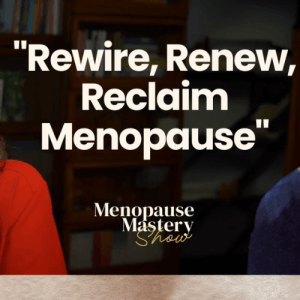Ketamine and Menopause: The Future of Mood Treatment
In the ever-evolving landscape of mental health treatment, ketamine has emerged as a promising player, particularly for mood disorders during menopause. As women navigate the physical and emotional changes of perimenopause and menopause, managing mood disorders becomes increasingly crucial. In a recent episode of the Menopause Mastery Podcast, Dr. Betty Murray sat down with Dr. Haviva Malina to discuss the transformative potential of ketamine-assisted therapy for women experiencing mood disorders. Here’s a closer look at the insights shared during their enlightening conversation.

Watch this episode on YouTube
Understanding Ketamine’s Role in Mental Health
Traditional antidepressants like SSRIs and SNRIs have long been the go-to treatments for depression and anxiety. However, their efficacy can be limited, especially when addressing mood disorders that arise during menopause. Dr. Malina emphasizes that while traditional antidepressants work on dopamine and serotonin pathways, ketamine operates differently by interacting with the glutamate pathway.
Ketamine’s unique mechanism involves blocking the NMDA receptor in the brain, which subsequently allows for an increase in glutamate. This not only has a direct antidepressant effect but also promotes synaptogenesis—the creation of new pathways in the brain. Such neural plasticity enables individuals to approach old challenges more constructively, providing a significant shift for those who haven’t found relief with traditional medications.
The Shift: From ER to Mental Health
Dr. Malina’s journey from emergency medicine to mental health was largely catalyzed by the COVID-19 pandemic. Observing the mental health repercussions in the ER, she and her sister-in-law pivoted their focus to ketamine-assisted treatment. They saw first-hand how swiftly and effectively it transformed patients’ lives in controlled, medically supervised environments. Today, their multiple clinics across New York and New Jersey are testaments to ketamine’s potential as a viable mental health treatment option.
Debunking Misconceptions: Ketamine’s Stigma
Often misclassified alongside street drugs or psychedelics like psilocybin, ketamine faces unwarranted stigma. Though it does have a transient psychedelic effect, Dr. Malina clarifies that it is a medically established treatment for depression. Its safety and efficacy, when administered in proper settings, are well-documented, distinguishing it from recreational drug use. Importantly, recent advancements have led to FDA approval for variations like Spravato, making ketamine more accessible.
The Perimenopause and Menopause Connection
Mood disorders are a prevalent issue during perimenopause and menopause, attributed to both hormonal fluctuations and life stressors. Women during this phase often experience depression and anxiety, exacerbated by traditional antidepressants known to worsen menopause-related issues like weight gain and low libido. Ketamine offers a rapid and effective alternative. Its ability to lift mood and motivate within days, as noted by Dr. Malina, presents a critical advantage for women needing immediate relief.
Tailored Approach: The Journey of Ketamine Treatment
Ketamine treatment is not a one-size-fits-all solution. Each patient undergoes a personalized consultation to determine the most suitable approach—whether IV ketamine or Spravato nasal spray. The initial phase involves frequent sessions to build up ketamine in the system, followed by a maintenance plan. Dr. Malina stresses the importance of this customized journey, highlighting the pivotal role of therapeutic support both pre and post-treatment. This holistic approach ensures patients maximize their neuroplastic window, making the therapeutic effects more permanent.
The Broader Implications of Ketamine Treatment
Dr. Malina and her team aim not only to treat patients but also to educate the broader medical community about ketamine’s potential. By improving patient outcomes and encouraging dialogue with psychiatrists and therapists, they hope to integrate ketamine into mainstream mental health treatment frameworks. Their mission aligns with breaking the inertia of traditional treatments and embracing innovative solutions that cater to the evolving needs of patients, especially women navigating menopause.
Final Thoughts: Embracing the Change
For women embarking on the menopause journey, exploring ketamine-assisted treatment could open avenues for renewed mental health. By understanding this unique therapeutic approach and debunking prevalent myths, women can make informed decisions that align with their specific needs. As clinics like Dr. Malina’s continue to expand and insurance coverage becomes more accessible, the prospects for widespread adoption of ketamine therapy look promising.
In closing, the conversation between Dr. Murray and Dr. Malina reinforces the importance of exploring new treatments that higher patient satisfaction and improved quality of life, particularly for those who have long battled mood disorders without success. As we advance, ketamine might well become a cornerstone in the landscape of menopause treatment, embodying hope and change for many.
